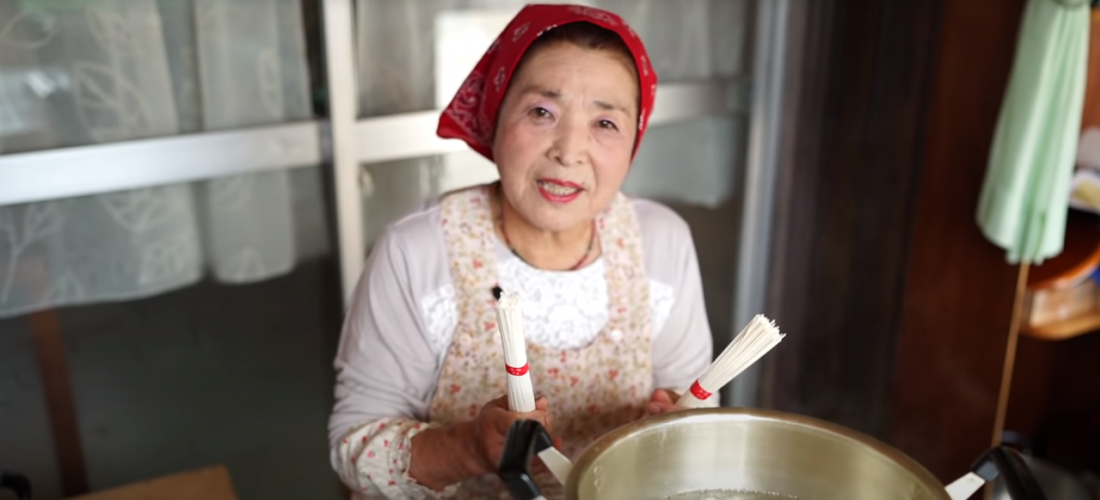If you thought forbidden mochi ice cream toast was extreme, then you’ve never seen Tokyo’s haute cuisine.
Shusaku Toba has earned stars from the Michelin guide for his work as owner-chef at Tokyo restaurant Sio, but his most recent newsworthy endeavor has been a little less "haute cuisine", and a little more "midnight snack."
Last year, the internet was ablaze with a new recipe called "forbidden mochi toast," and home cooks sung the praises of a slice of white bread toasted with American cheese and Yukimi Daifuku brand mochi ice cream. A "forbidden" but apparently delicious combination of flavors, perfect as a midnight snack, or quick sweet indulgence. But where does Shusaku Toba come into the story? Well, this spring Yukimi Daifuku is at it again, and they're aiming for the stars (Michelin stars, apparently). Chef Toba has taken a break from his busy schedule preparing elegant French cuisine in Tokyo, to come up with some new takes on the classic (?) forbidden mochi toast recipe.
/
ミシュラン一つ星「sio」#鳥羽周作 シェフ考案#雪見シュラン アレンジ
\ナイフとフォークで楽しむ
#禁断の雪見トースト#ベーコンエッグ雪見
あまじょっぱさがクセになる禁断の一品。
とろけた #雪見だいふく と目玉焼き
の禁断のコラボが生み出す感動のおいしさをお試しあれ
pic.twitter.com/NtUlJTckvN
— ロッテ 雪見だいふく (@yukimi_lotte) May 17, 2021
The theme of this Yukimi Daifuku promotion is "Restaurant Yukimi," and unlike the basic forbidden mochi toast, these recipes are made to be eaten with a knife and fork. So the first recipe is a "sweet and salty forbidden dish" that they suggest might just be addictive: bacon and egg Yukimi Daifuku toast.
In the video posted on both the Yukimi Daifuku official Twitter, and also Chef Toba's account, the chef quickly whips up the perfect sunny side up egg, fries some bacon, and then covers them with melty, toasted ice cream mochi. The final dish is splashed with a few drops of soy sauce, and Chef Toba digs in with gusto, finally declaring the dish so delicious that he's shaking. Literally, shook.
#雪見だいふく× 鳥羽周作
ナイフとフォークで楽しむ#禁断の雪見トースト 第2弾
誰がどうみてもうまい
王道のスイーツにしました感動のおいしさをぜひ
作り方は動画にて#PR #雪見シュラン pic.twitter.com/jaevff4Y5R— 鳥羽 周作 (@pirlo05050505) May 16, 2021
After the insanity of that last breakfast bonanza, the second recipe from Shusaku Toba might not be so eyebrow-raising to anyone who's ever had a good apple pie. Because "apple pie Yukimi Daifuku toast" is just what it sounds like: buttered toast, the ubiquitous slice of American cheese, a good layer of apple jam, toasty-melty ice cream mochi, and a final sprinkling of cinnamon on top. After getting over the initial shock of the original forbidden mochi toast, this seems like a pretty mundane treat. Chef Toba does seem to think it's so good that he "want[s] to go to all kinds of people's houses and make this for them," though.
The recipes each came with instructions for unique cups of tea meant to accompany the toast, posted in the comments of the original tweets, which probably wouldn't surprise anyone who's kept up with Chef Toba's restaurant Sio, lately. Tokyo's recent state of emergency announcements have called for restaurants to close early, cutting into normal dinner hours, and Sio has responded by starting to offer their multi-course dinner menu early in the morning as well, as breakfast. And while a fancy brunch elsewhere in the world might mean bottomless mimosas, Chef Toba has decided to replace the wine accompaniments he normally offers, when it comes to breakfast, and instead pair each dish with a different kind of tea. We can see the influence of that new Sio breakfast revolution in the teas paired with the toasts, and perhaps in the breakfast-themed bacon and egg recipe as well.
While these recipes seem a little ridiculous, Twitter users have been posting their own experiences with the basic forbidden mochi toast for months now, with all signs pointing to delicious. And according to the dramatic (and perhaps surprised) reaction of Chef Toba himself, halfway through his meal of apple pie Yukimi Daifuku toast, "it's actually delicious."
Maybe the recipes are really worth a try.
For more info and updates from Japan, check Japankuru for new articles, and don't forget to follow us on Twitter, Instagram, and Facebook!
Details
NAME:Yukimi Daifuku (雪見だいふく)
Between collaboration items and special-edition limited-time-only goods, Japan has some pretty interesting products, and if you're anything like me... well, you can't help but be interested!
COMMENT
FEATURED MEDIA
VIEW MOREMAP OF JAPAN
SEARCH BY REGION

LATEST
VIEW MOREEVENT CALENDAR
VIEW MOREMOST POPULAR
 Tokyo Winter Recommendation: Don’t Miss Tokyo Mega Illumination, Japan’s #1 Light Show
Tokyo Winter Recommendation: Don’t Miss Tokyo Mega Illumination, Japan’s #1 Light Show ป้ายยาสินค้าน่าซื้อในร้านขายยาญี่ปุ่น | KOWA ผลิตภัณฑ์เพื่อสุขภาพสำหรับคนยุคใหม่
ป้ายยาสินค้าน่าซื้อในร้านขายยาญี่ปุ่น | KOWA ผลิตภัณฑ์เพื่อสุขภาพสำหรับคนยุคใหม่ Okinawa Family Road Trip: Japanese Glasses Shopping at San-A Urasoe West Coast PARCO CITY, Discount Coupons, & Okinawa Sightseeing with JINS
Okinawa Family Road Trip: Japanese Glasses Shopping at San-A Urasoe West Coast PARCO CITY, Discount Coupons, & Okinawa Sightseeing with JINS









 >> Find out more at Japankuru.com! (link in bio)
#
>> Find out more at Japankuru.com! (link in bio)
#





 The Robot Restaurant is gone, but the Samurai Restaurant is here to take its place. Check it out, and don't forget your coupon!
The Robot Restaurant is gone, but the Samurai Restaurant is here to take its place. Check it out, and don't forget your coupon!
 신주쿠의 명소 로봇 레스토랑이 사무라이 레스토랑으로 부활! 절찬 쿠폰 발급중
신주쿠의 명소 로봇 레스토랑이 사무라이 레스토랑으로 부활! 절찬 쿠폰 발급중
 18歲以上才能入場的歌舞秀,和你想的不一樣!拿好優惠券去看看~
#tokyo #shinjuku #samurairestaurant #robotrestaurant #tokyotrip #도쿄여행 #신주쿠 #사무라이레스토랑 #이색체험 #할인이벤트 #歌舞伎町 #東京景點 #武士餐廳 #日本表演 #日本文化體驗 #japankuru #japantrip #japantravel #japanlovers #japan_of_insta
18歲以上才能入場的歌舞秀,和你想的不一樣!拿好優惠券去看看~
#tokyo #shinjuku #samurairestaurant #robotrestaurant #tokyotrip #도쿄여행 #신주쿠 #사무라이레스토랑 #이색체험 #할인이벤트 #歌舞伎町 #東京景點 #武士餐廳 #日本表演 #日本文化體驗 #japankuru #japantrip #japantravel #japanlovers #japan_of_insta

































 Oita Hello Kitty Airport
Oita Hello Kitty Airport  Lands April 13th
Lands April 13th






















